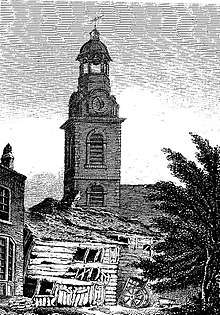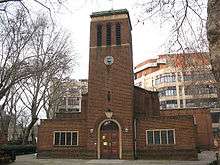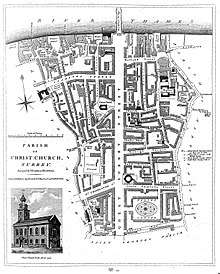Christ Church, Southwark
Christ Church, Southwark, is a church of the Anglican denomination situated on the west side of Blackfriars Road, London. At the time of the foundation there was no bridge at Blackfriars and so no major road connecting the area to the south or to the City.



The current church was built in 1958, following total destruction of the previous building in 1941, during the London Blitz. It has been Grade II listed since 2010.[1]
Windows
The church has two large sequences of stained glass, one of 1959 by Kenneth Bunton, the other of 1984 celebrating the church's 25th anniversary by John Lawson, both showing features of life within the parish. The first range memorably includes a London Transport bus. The latter range includes buildings as diverse as Sampson House, the Lloyds Bank Computer Centre, Sea Containers House, the Kirkaldy Testing Museum and a J Sainsbury supermarket. Some of the industries and commercial businesses depicted in the 1984 glass have since left the area.[2]
History

The parish of Christ Church, Surrey was created by Act in 1682 in the manor of Paris Garden as a result of the gift under the direction of the executors of John Marshall, a member of a Southwark family of “whitebakers”. This was previously part of the St Saviour’s parish. His will, of 1627, provided from 1637 and directed that a new church should be built and a Rector be appointed and paid for in that Manor, the most easterly part of St Saviour's parish. He died in 1631. The church was built in 1671.
This charity still provides for these purposes. The John Marshall Trustees are independent of the parochial charities and the wealth they have accumulated for its objects are distributed over most of the counties of Kent, Surrey (including those parts now in Greater London) and Lincolnshire. The beneficiaries are Rectors of parishes of the Church of England. The first charge on the charity is the maintenance of Christchurch which they have completely rebuilt in 1738. The first had been built on marshy ground, and by the 1720s was in a poor condition and collapsed. By an Act of Parliament dated 1738, the trustees were empowered to demolish the church and rebuild it in an improved enclosure. By 1741 the new Christ Church had been completed in Italian Romanesque style with a clocktower rising in three stages from the ground, surmounted by an octagonal lantern and cupola.
Marshall is commemorated in the porch of the church by his coat of arms and also the attached church hall is also named after him. It is also the home of the South London Industrial Mission.
Its parish coincided with the manor of Paris Garden, mentioned by Shakespeare in his play Henry VIII as being, at that time, a disreputable place. Its jurisdiction was outside that of the Bishop of Winchester's 'Liberty of the Clink' to its east and the Archbishop of Canterbury's Manor of Lambeth to its west.
Today this is an office location north of Southwark Station on the London Underground Jubilee line, and forms part of the London Borough of Southwark.
Notes
- Printed information sheet “John Marshall’s Charity” ca 1995, provided by Clerk to the Trustees.
- Papers of the United Charities of Christchurch.
- Report of the Charity Commission South London Parish Charities 1822 pp72–75.
- Report of the Charity Commission South London Parish Charities 1890 pp 92–99
References
- Historic England, "Christ Church (1395086)", National Heritage List for England, retrieved 1 August 2017
- "Christ church windows set on flickr". Retrieved 4 June 2017.